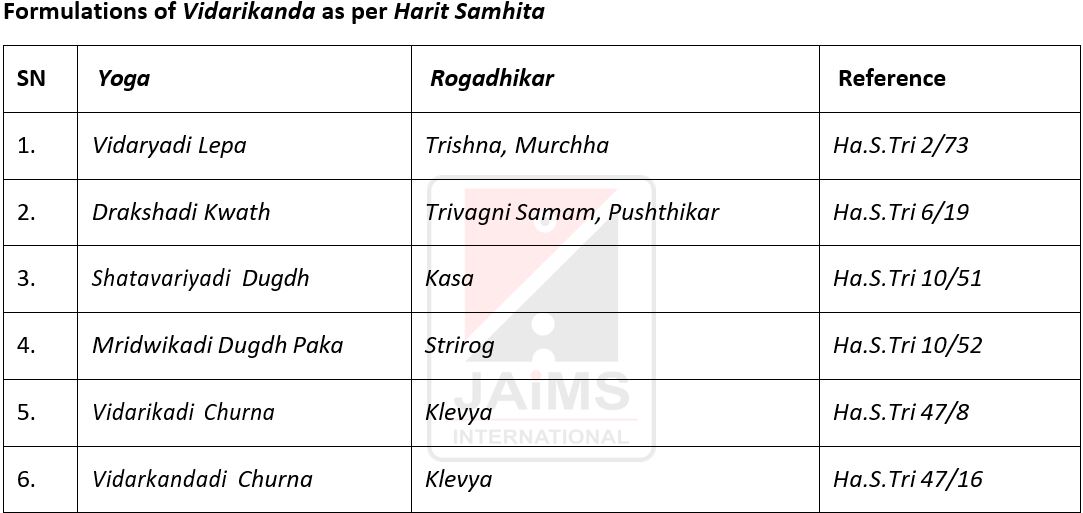Critical Review on Vidarikanda (Pueraria tuberosa Dc.)
DOI:
https://doi.org/10.21760/jaims.10.6.18Keywords:
Vidarikanda, Rasayan, Jiwaniya, Vrishya, BalyaAbstract
Background: Vidarikanda is a perennial woody climber and important drugs which has described in all Ayurvedic text including Laghutrayi and Vrihatrayi and in all Nighantus. Vidarikanda is important medicinal drugs which is being used as single or in combination from ancient time. All the Ayurvedic text have mention the various properties of Vidarikanda and it is used in different diseases and different pathological condition.
Aim and Objectives: To illustrate the medicinal value, its properties and therapeutic importance of Vidarikanda in different type of diseases and illness.
Material and method: Different Ayurvedic textbook, references and different modern medicine science text and various research article and clinical research published in journal have been reviewed.
Result and discussion: Vidarikanda have Ayurvedic properties like Ras- Madhur, Virya- Sheet, and Guna- Snigdha. Due to these properties Vidarikanda pacify Vata, Pitta, and, Rakta Dosha and performing action like Balya, Jiwaniya, Vrishya, Rasayan, Sukral and Stanya which have described in ancient Ayurvedic text. Due to these vital properties Vidarikanda are being used from ancient time to treat different type of diseases and as a health promoter and as a highly nutritive source. It is mostly used in Kshatkshina, Rajyakshma, Kasa, Vatrakta, Krisha, Shosha, Apasmar, Jwar, Raktapitta, Vatvyadhi, Klaibya and many other diseases. It is very useful as immunomodulatory diseases, anti-inflammatory, rejuvenator cardiotonic, antioxidant.
Downloads
References
Charaka. Charak Samhita [Hindi commentary by Pt. Kashinath Shastri and Dr. Gorakhnath Chaturvedi]. Varanasi: Chaukhambha Bharati Academy; 2008. p. 383.
Chunekar KC. Bhavaprakash Nighantu, Guduchyadi Varga, verses 180–182. Varanasi: Chaukhambha Bharati Academy; 2004. p. 387.
Ministry of Health and Family Welfare, Government of India. The Ayurvedic Pharmacopoeia of India. Part I, Vol II & V. New Delhi; p. 173, 224.
Ministry of Health and Family Welfare, Government of India. The Ayurvedic Pharmacopoeia of India. Part I, Vol II & V. New Delhi; p. 173, 224.
Ministry of Health and Family Welfare, Government of India. The Ayurvedic Pharmacopoeia of India. Part I, Vol II & V. New Delhi; p. 173, 224.
Chunekar KC. Bhavaprakash Nighantu, Guduchyadi Varga, verses 180–182. Varanasi: Chaukhambha Bharati Academy; 2004. p. 387.
Ojha J, Mishra U. Dhanvantari Nighantu, Guduchyadi Varga, verses 147–148. Varanasi: Chaukhambha Surbharati Prakashana; 2004. p. 53.
Bapalal G. Nigantu Aadarsh, Palashadi Varga, verse 399. Varanasi: Chaukhambha Bharati Academy; 2007. p. 399.
Pandey G. Madana Pal Nighantu, Abhyadi Varga. Varanasi: Chaukhambha Orientalia; 2012. p. 140–141.
Sharma P, Sharma GP. Kaiyadeva Nighantu, Aushadhi Varga, verses 1579–1584. Varanasi: Chaukhambha Orientalia; 2009. p. 638.
Pandey KP, Singh AN. Gunaratnamala, Guduchyadi Varga. Varanasi: Chaukhambha Sanskrit Bhawan; 2006. p. 258–259.
Tripathi I. Raj Nighantu, Mulakadi Varga, verses 99–103. Varanasi: Chowkhamba Krishnadas Academy; 2010. p. 206–207.
Sharma P. Priya Nighantu, Pipalyadi Varga, verses 43–45. Varanasi: Chaukhambha Surbharati Prakashana; 2004. p. 65.
Charaka. Charak Samhita [Hindi commentary by Pt. Kashinath Shastri and Dr. Gorakhnath Chaturvedi]. Varanasi: Chaukhambha Bharati Academy; 2008.
Sushruta. Sushrut Samhita [Hindi commentary by Kaviraj Ambikadatta Shastri]. Varanasi: Chaukhambha Sanskrit Sansthan; 2007.
Vagbhata. Ashtang Hridaya [Hindi commentary by Kaviraj Atrideva Gupta]. Varanasi: Chaukhambha Prakashan; 2009.
Harita. Harita Samhita [Hindi commentary by Pt. Hari Prasad Tripathi]. Varanasi: Chaukhambha Krishnadas Academy; 2009.
Bhela. Bhela Samhita [Hindi commentary by Shri Abhay Katyayan]. Varanasi: Chaukhambha Surbharati Prakashan; 2009. Chikitsa Sthana 14/12. p. 390.
Vaidyaratnam P.S. Indian Medicinal Plants: A Compendium of 500 Species. Vol 4. Kottakkal: Orient Longman Publishing; 1997. p. 391–395.
Bhagat VV, Kotangale YT, Rampurkar MV. To study the Brimhan Siddhant on the basis of efficacy of Vidarikand on Karshya Vyadhi. Int Ayurved Med J (IAMJ). 2015;3(5).
Tripathi AK, Kohli S. Anti-diabetic activity and phytochemical screening of crude extracts of Pueraria tuberosa DC. (Fabaceae) grown in India on STZ-induced diabetic rats. Asian J Med Pharm Res. 2013;3(3):66–73.
Maji AK, Mahapatra S, Banerjee D. In-vivo immunomodulatory potential of standardized Pueraria tuberosa extract and its isoflavonoids. Int J Pharm Pharm Sci. 2014;6(1).
Pandey N, Chaurasia JK, Tiwari OP, Tripathi YB. Protective effect of Pueraria tuberosa on oxidative stress and antioxidant status in diabetic rats. Food Chem. 2007;105(1):219–22.
Verma SK, Jain V, Vyas A, Singh DP. Protection against stress-induced myocardial ischemia by Indian Kudzu (Pueraria tuberosa) – a case study. J Herb Med Toxicol. 2009;3(1):59–63.
Verma SK, Jain V, Vyas A. Fibrinolysis enhancement by Pueraria tuberosa (Indian Kudzu) in patients with coronary artery disease: a placebo-controlled study. Journal of Cell and Tissue Research. (2009) Vol. 9(1) 1649-1654
Penetar DM, Maclean RR, McNeil JF, Lukas SE. Kudzu extract treatment does not increase the intoxicating effects of acute alcohol in human volunteers. Alcohol Clin Exp Res. 2011 Apr;35(4):726-34. doi: 10.1111/j.1530-0277.2010.01390.x. Epub 2011 Jan 18. PMID: 21244439; PMCID: PMC3074930.
Mishra RN. The Vajikaran (aphrodisiac) formulations in Ayurveda. Int J Res Pharm Chem. 2012;2(1).
Chauhan NS, Sharma V, Thakur M, Sawaya ACHF, Dixit VK. Pueraria tuberosa DC extract improves androgenesis and sexual behavior via FSH-LH cascade. Sci World J. 2013;2013.
Rao NV, et al. Nootropic activity of tuber extracts of Pueraria tuberosa. Indian J Exp Biol. 2008;46(Aug):591.
Pandey N, Yadav D, Pandey V, Tripathi YB. Anti-inflammatory effect of Pueraria tuberosa extracts through improvement in activity of red blood cell antioxidant enzymes. AYU. 2013;34(3):297–301.















